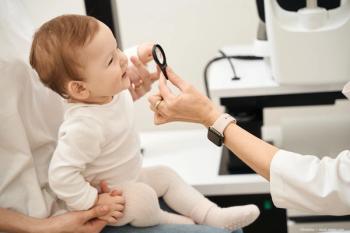
Still working to solve the ROP puzzle
The burden of retinopathy of prematurity (ROP) is great, and researchers are still working to find the most effective and safest treatments, said David Barañano, MD, PhD, at the 24th annual Current Concepts in Ophthalmology meeting.
Baltimore-The burden of retinopathy of prematurity (ROP) is great, and researchers are still working to find the most effective and safest treatments, said David Barañano, MD, PhD, at the 24th annual Current Concepts in Ophthalmology meeting.
ROP remains one of the leading causes of blindness in children, began Dr. Barañano, who is assistant professor of ophthalmology, Johns Hopkins University School of Medicine-Wilmer Eye Institute, Baltimore. In the United States, about 500 children per year lose their vision due to ROP. ROP has a stereotyped disease course, and usually becomes apparent by 32 weeks gestational age. The threshold incidence peaks at 37 weeks gestational age, he said.
In 1984, the international community issued a classification system for this disease based on stages that reflect the progression of the disease:
Stage 1 is the mildest, and is signified by a line that demarcates avascular retina from vascular retina.
Stage 2 develops when a thick, elevated ridge develops.
Stage 3 occurs when epiretinal neovascularization occurs.
Stage 4 occurs when the vessels contract and partially pull the retina off the back of the eye.
Stage 5 consists of retrolental fibroplasia, or total retinal detachment.
“It is important to understand that at any point-especially during the first few stages-this disease can regress either spontaneously or with appropriate treatment,” Dr. Barañano said.
“In a state of relative hypoxia, the avascular retina in the periphery produces the pro-angiogenic factors that lead to the problem. It makes sense that destroying the avascular retina may halt the process, and this was first demonstrated in the 1980s with the CRYO-ROP trial,” he added.
Careful screening combined with timely and complete ablation of peripheral avascular retina is highly effective for most cases of ROP, said Dr Barañano. In addition, careful attention to oxygen exposure can reduce the rates of ROP. Finally, although off-label, the use of bevacizumab (Avastin, Genentech/Roche) in these young patients is likely to play an important role in severe posterior disease, but the indications, timing, and follow-up are unknown at this time.
Laser treatment has been demonstrated to be at least as efficacious as cryotherapy in treating ROP, continued Dr. Barañano. The Early Treatment of Retinopathy of Prematurity (ETROP) Trial refined treatment criteria to include those with a 15% chance of developing a threshold characteristic. These infants were treated earlier than they would have been otherwise and did far better. Only 9% of infants treated early developed unfavorable anatomy compared with 16% of conventionally managed infants.
“There is clearly room for improvement, even with the refined ETROP criteria,” Dr. Barañano said. “One of the biggest improvements is the screening, especially in developing countries, where improvements in acute care have outpaced ophthalmic monitoring of these infants. There is a pressing need for improved screening, whether through telemedicine or computer-assisted image analysis to detect plus disease.”
One option that is continuously being explored is efforts to augment oxygen levels in infants with ROP, continued Dr. Barañano. Oxygen therapy is usually begun in stage 1 of the disease, when the infant is in a state of relative hyperoxia. During this time, relatively lower oxygen levels may minimize the halting of the normal vascular process. A physiologically reduced oxygen protocol has been adopted at many NICUs over the past 5 years, but it is rather complex, and requires state-of-the-art oxygen monitoring systems and specialized training for the staff to ensure appropriate incremental changes in oxygen saturation. Chow and colleagues analyzed retrospective data on this new protocol, and found a dramatic decrease in severe ROP from 12% to 2.5%. A study by Sears et al. and one by Wright et al. both found similarly dramatic decreases in the rate of severe ROP.
Oxygen therapy nearly abolished the need for laser in these cohorts. None of these studies were powered by mortality, however, noted Dr. Barañano, nor were they randomized trials.
“There was a lot of excitement about these new oxygen protocols, and how they might decrease our ROP burden. Unfortunately, two very large randomized, controlled trials recently found that there is an increased infant mortality with the new oxygen protocol. For this reason, some NICUs are backing away from this new oxygen protocol,” he explained.
The advent of these trials that showed oxygen therapy perhaps to be detrimental in infants with ROP highlighted the necessity to explore different treatment options. One of these options involves addressing the pro-angiogenic factors that are involved in the pathogenesis of ROP, Dr. Barañano explained.
“Bevacizumab and ranibizumab (Lucentis, Genentech/Roche) are anti-vascular endothelial growth factor (VEGF) agents, and seem to be a natural choice for a disease such as ROP,” Dr. Barañano said.
In 2007, researchers first reported a dramatic effect in infants with these two anti-VEGF agents, and since then, at least six large case series have described the use of bevacizumab.
“The results are compelling, and infants experienced a very rapid regression of plus disease in all cases. Numerous [researchers] have reported complete avoidance of laser, and they have beautiful examples of normal-appearing vessels actually progressing beyond the demarcation after the treatment,” Dr. Barañano noted, adding that there was about a 5% incidence of contraction and cicatricial changes accelerated by the injection.
“There has been a growing consensus among those who treat ROP that bevacizumab has a role as rescue therapy in situations in which the clinician is unable to treat the eye with laser, either due to anterior rubeosis, vitreous hemorrhage, or cataract. Before the availability of intravitreal bevacizumab, these eyes [would] end up with no light perception, and bevacizumab may reverse the process,” Dr. Barañano stressed.
Other rescue therapy indications may include those eyes in which persistent avascular activity occurs, despite complete laser treatment.
“In cases where the complete avascular retina is treated and there is still persistent avascular activity, bevacizumab may have a role as rescue,” he said.
Finally, there are the eyes that have already undergone detachment but have a considerable amount of vascular activity to the point where surgery would be unsafe. In these cases, bevacizumab used as an adjunct allows for surgery to be performed at an earlier time, when there is still some hope for a successful outcome.
“In these very fragile and young infants, we are mindful that there are some very serious safety concerns,” Dr. Barañano said.
Adverse ocular effects have been reported. In one of the first reports of the use of bevacizumab in infants, related Dr. Barañano, a 23-week-old infant developed a severe cicatricial contractual detachment 24 hours after injection.
“This was thought to be due to the rapid regression of vascular proliferation. There was also an example of a choroidal rupture 24 hours after injection in another infant,” he noted.
The more pressing question, however, is whether there are significant systemic consequences to the use of potent anti-angiogenic therapy for these very fragile patients. Although the safety profile of these agents for adults is good, concerns about their effects in such tiny patients is great, noted Dr. Barañano.
“In infants with ROP, the blood-eye barrier is not fully established,” he said. “Bevacizumab injected intravitreally actually shows up [at] measurable, pharmacologically relevant levels in the serum of these infants as early as 24 hours after injection,” Dr. Barañano explained. “Not only does the medicine end up in the blood, but the serum levels of VEGF actually drop in these children almost 10-fold. When we think of the physiologic angiogenesis that is occurring in the lungs and in the brains in these infants at this time, this finding should give us pause,” he stressed.
Despite these concerns, there is a growing movement toward using bevacizumab as primary therapy in these infants, as contrasted with rescue therapy. Some of the potential theoretical advantages cited for this approach include the potential to spare some visual field and prevent myopia related to laser ablation.
“Laser treatment is definitely associated with cataract, and there can also be angle damage and potentially strabismus. There’s no doubt that the bevacizumab treatment is less stressful to the infant than laser. It’s a far more elegant from a pathophysiology standpoint, a simpler technique, and a far more efficient method of care. But, we don’t know the systemic risks of this medicine, and we don’t know the risks of injection in a small infant whose pars plana has not developed,” he said.
According to Dr. Barañano, there is a clear need for randomized, prospective data to guide this decision. In 2010, Mintz-Hittner and colleagues completed a randomized, prospective, multicenter trial (BEAT-ROP) of 150 infants that compared bevacizumab injection (0.75 mg) with laser treatment for posterior disease.
The unusual primary outcome, investigator-determined need to re-treat for “recurrence” of neovascularization, makes it difficult to draw clinically useful conclusions.
Data showed that re-treatment rates were lower for bevacizumab, at least over the relatively short follow-up of the trial. Four percent of infants assigned to receive bevacizumab were re-treated, whereas 22% of infants treated with laser received further laser treatment. When analyzed by zone, the difference was statistically significant for zone 1 but not zone 2.
There were a few notable caveats, Dr. Barañano said.
“First, these outcomes were unusual in that they were not looking at the anatomy of the eye or the visual outcome. They simply looked at the need to re-treat. The timing of re-treatment of the two therapies varied and many of the bevacizumab re-treatments occurred toward the end of the follow-up. The relatively high re-treatment rate [with] laser suggests incomplete peripheral ablation. This is common in posterior disease. A second session of laser [treatment] is often employed after regression of the tunica vasculosa and neovascularization allows for better visualization. This is better thought of as a staged procedure rather than ‘treatment failure.’ In addition, the decision to re-treat was made by the unmasked investigators. Finally, the trial was not designed to assess safety,” he explained.
Currently, researchers are preparing to start a separate randomized, prospective, multi-centered trial that will look at type 1 pre-threshold disease randomly assigned to two doses of bevacizumab versus laser treatment. Outcomes will consist of Teller acuity at 1 year, retinal structure, and developmental scores.
“When considering bevacizumab for ROP, it’s important to weigh the risks and benefits very carefully. If I think there’s a chance that the child can get vision without bevacizumab, I think laser is the right choice in 2011. I do use [bevacizumab] occasionally as adjunct therapy in vascularly active eyes that require surgery, and I think it’s appropriate as well for very posterior disease that will not do well with laser. But these children must be monitored closely after injection, and prompt vitreoretinal intervention should be available in case contracture leads to retinal detachment,” concluded Dr. Barañano.
Once these children receive intravitreal bevacizumab, they must be followed closely for a much longer period than conventionally treated children. The medicine can wear off. The BEAT-ROP study reported an average re-treatment interval of 19.2 ± 8.6 weeks. Thus, in contrast to conventionally managed infants, a significant fraction of infants treated with bevacizumab appear to develop recurrence of active neovascularization after 60 weeks adjusted gestational age.
Dr. Barañano did not indicate any financial interest in this topic.
References
Chow LC, Wright KW, Sola A. Can changes in clinical practice decrease the incidence of severe retinopathy of prematurity in very low birth weight infants? Pediatrics. 2003;111:339-345.
Mintz-Hittner HA. Avastin as monotherapy for retinopathy of prematurity. J AAPOS. 2010;14:2-3.
Sears JE, Pietz J, Sonnie C, Dolcini D, Hoppe G. A change in oxygen supplementation can decrease the incidence of retinopathy of prematurity. Ophthalmology. 2009;116:513-518. Epub 2009 Jan 20.
Wright KW, Sami D, Thompson L, Ramanathan R, Joseph R, Farzavandi S. A physiologic reduced oxygen protocol decreases the incidence of threshold retinopathy of prematurity. Trans AmOphthalmol Soc. 2006:104:78-84.
For more articles in this issue of Ophthalmology Times eReport,
Newsletter
Don’t miss out—get Ophthalmology Times updates on the latest clinical advancements and expert interviews, straight to your inbox.













































